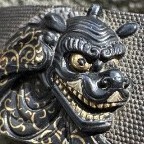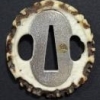-
Posts
459 -
Joined
-
Last visited
-
Days Won
3
Jake6500 last won the day on April 5
Jake6500 had the most liked content!
Profile Information
-
Gender
Male
-
Location:
Melbourne Australia
-
Interests
Collecting authentic Tsuba and Japanese history generally.
Profile Fields
-
Name
Jake
Recent Profile Visitors
2,676 profile views
Jake6500's Achievements
-
I concur, the Nanako look pretty great, quality of materials are high and most importantly the mei+kao looks like a spot on match. I think you've struck gold, congratulations Okan! I've also had a look at a few other examples of the mei on various kozuka and such and there is little doubt in my opinion.
-
I think it has very clearly been carved up that way for decorative effect. Tsuba seems modern to me also. No signs of mounting, looks a little too perfect. Nakago Ana also looks weirdly off-centre as well, or is it just my eyes playing tricks on me?
-
Thanks Justyn, I must confess it is currently the single most expensive piece I have in my collection and I was happy to have an excuse to share it here! I have started to gravitate toward the Hamano style and am a big fan of contrast pieces. The contrast between shibuichi and gold is something I find quite appealing...
-
When you start out you tend to prioritise motif/design/theme more than quality. It takes at least about a year of deep involvement in the hobby before you start to develop the eye for quality. Honestly I am still developing my own. Your collection also starts off kind of random to start (at least, mine did). I recommend starting off just aiming to buy real authentic Edo Period pieces with designs you personally like, for reasonable prices. Aim to keep your purchases below 500-600 AUD at maximum when you start out and just focus on learning to discern real Edo pieces from casts or reproductions. As time goes on you'll begin to get a sense for quality of craftmanship as well as materials and then you can start to save up for more expensive pieces. You can get some very nice quality pieces for that price, believe it or not. The fuchigashira in my profile picture is one of my best pieces and I picked it up in an auction on Jauce for about $550 AUD. I've only very recently started spending more than that on higher quality pieces now that I have developed my eye a bit. I also recommend using Jauce or a similar service to access Japanese Yahoo auctions as you can find great pieces there, often for better prices than direct from dealers or from Ebay. Keep using and reading the forum frequently as it is a great source of knowledge and once you figure out what sort of style you like (which may take a while) start doing some online research and compiling examples of quality work in that style or from that school. Building something like a digital archive of pieces will help. If you read the forum consistently, train your eye by looking through listings regularly and most of all are patient, you'll begin to develop a decent eye for quality and an ability to discern reasonable price ranges within a year.
-
The design is kind of interesting. The oni peering through the bars is innovative so I understand where the sentiment comes from, but $3600 USD is crazy! $600 USD is already probably more than I'd pay unless it came with certification.
-
I still think it was made in Japan and likely is an authentic mid-late Edo Period piece. I don't think the quality is bad, but I also don't think it's spectacular. As Colin says, vastly overpriced. I wouldn't pay more than maybe 1/6th the asking price unless I was absolutely 100% certain the mei was authentic. When you compare it to the other examples I posted, I'm doubtful.
-
My opinion is it is likely an authentic tsuba. It looks like later Edo work (as the listing says, 1750's onward seems plausible). Quality is good (although price tag isn't cheap!) With regard to the tagane punch marks in the nakago-ana, my guess is that this has been inserted for beautification as a throwback to older styles. I don't think it is major cause to doubt the periodisation in and of itself. I think the biggest question for me is whether or not the mei on this tsuba is authentic or gimei, because I wouldn't even dream of paying the price I see listed on this thing unless it was a style + artist I was big on and I was absolutely 1,000% certain both the tsuba and the mei were authentic. The mei appears to be referring to Sugiura Issando Nagaharu Jo-i, an artist active in the 1760's who often signed "Jo-i" or "Issando Joi". From a preliminary search about this particular artist gimei pieces are quite common so I would be trying to find verifiably authentic pieces and making some very close comparisons of both mei and style before purchasing. One other concern is something about the linework in the tree on the Ura seems kind of modern to me and gives off a bit of a Meiji Period vibe. That said, I've seen marks like those underneath the tree in authenticated Hamano Shozui works from the 1750's so I still think 1750's is plausible. Some other pieces purportedly by the same artist for comparison: TLDR; Probably a real tsuba but might be gimei. Check style and signature extra carefully before buying. For me, I'd be wary just because of the price.
-
Yeah I've seen these popping up lately. There was one on Jauce the other day as well (not sure if it's still there). I pity anyone new to the hobby who gets burned on one of these hockey pucks... They are often listed with the "Hamano" attribution in the listing despite having few stylistic similarities or lacking any discernible clarity or similarity due to the poor quality. The papered tsuba looks more like something resembling Hamano style work. It gives you an idea of what the original tsuba from which all these copies were produced likely looked like. That said, given how many of these are floating around I would operate on the assumption that it too is just a higher quality reproduction. Certainly wouldn't trust it either.
-
True, their photographs are clear but very dark. I have had the same thought hahaha
-
Hi Damon, be aware that this tsuba is doubtful to be a genuine Nagatsune Minamoto piece and is most likely gimei. In general the majority of pieces floating around out there with this mei are gimei pieces. Here is an authentic Ichinomiya/Minamoto Nagatsune tsuba. The quality should be apparent at a glance... I myself have a fuchi signed "Echizen Daijo Minamoto Nagatsune" in my collection though it too is likely gimei...
-
A very famous scene that appears throughout the Edo Period in Tosogu pieces Justyn! You see this motif a lot on fuchigashira and on the occasional tsuba as well. Here is an example from my collection that I acquired not too long ago signed "Hamano Noriyoshi". You should hopefully recognise similarities from your own such as the bow in the mouth of the riding samurai on your tsuba! The samurai should be Kajiwara Kagesue riding Minamoto no Yoritomo's horse. Here is a woodblock for comparison:
-
Wow, this is interesting Dale. I purchased a high quality Yanagawa school kozuka just a couple months ago with basically this exact tanuki and moon design... Had never thought it might show up on a tsuba or other tosogu!
-
Quaint but not for me... But did you catch that Fujin tsuba that just sold for 4000 AUD? That one was right up my alley and way beyond my financial limitations! Would have liked to display it alongside the tengu kashira in my profile picture but alas, some big spenders locked eyes on it! There are a pair of other certified Omori school fuchigashira on Jauce up for grabs right now for anyone interested in this specific style...
-
No expert on these by any means but as for the period I'd probably guess early Edo, maybe 1650-1680ish based mostly on the shape of the Hitsu Ana and the apparent thickness which to me suggests early Edo but not Momoyama attribution. I've also read that Yagyu style tsuba became popularised by Yagyu Ren'ya born in 1625... I'm sure other forum members could tell you a lot more than I, so take my rough period attribution with an ample grain of salt.
-
I see what you are saying and you definitely can find the 9 star Kuyomon or Hanabishi in both areas, however as far as i know the use of the encircled Hanabishi and Kamei clan mon do not appear in the Eastern regions... Then again with all the different mon and samurai families that were floating around who knows? Thanks for posting the maps Piers, they're a great resource! This thread has resulted in an interesting discussion and I've learned a lot. Bruno's tsuba is definitely the closest matching example I have seen.


.thumb.png.4c5df79fec171b2dc4a23af38e280a4d.png)







